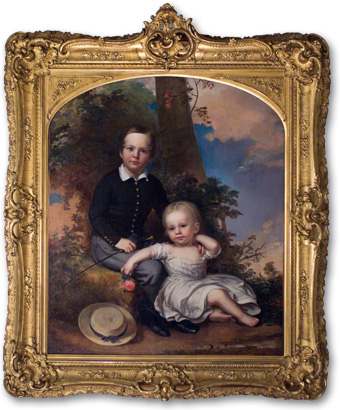 |
 |
||||||
 |
|||||||
 |
|||||||
Portrait Description The Campbell Boys Hugh Campbell, born in 1847, was considered the life of the party and a grand entertainer who loved to sing and play the piano. In later life, he was “Mr. Murphy” to neighborhood children with a stash of candy and dimes in-the-ready. The local boys’ home was invited for Christmas dinner. After a hip injury, he became a recluse. He died of heart disease in 1931 at age eighty-three. Hazlett Kyle Campbell, born in 1858, was the second child named Hazlett. Hazlett and James Alexander, born two years later were very close. Hazlett became mentally unstable after his mother’s death and more so after James died in 1890. Hugh took Hazlett to medical specialists across Europe, but his efforts proved futile. Today Hazlett would probably be diagnosed as suffering from manic depression and schizophrenia. Hazlett became ever more reclusive as the years passed. In 1924, he suffered a paralytic stroke. After Hugh’s death in 1931, the courts declared Hazlett of unsound mind. A doctor visited Hazlett daily from then until his death in1938 at age eighty. James Alexander Campbell, born in 1860, was thought to be his parent’s and his brother’s favorite. After attending Yale University from 1879 to 1882, James traveled with his brothers across Europe before entering Harvard Law School. He graduated with honors in 1888. The next year, James, Hugh, and Hazlett rented an apartment in Paris. James caught a flu virus and died of pneumonia in Paris in1890. The early deaths of the Campbell children illuminate living conditions and medical practices of the time. The Campbells’ indoor plumbing was a luxury, but water came straight from the Mississippi River. It was dirtier than cistern or well water, carrying diseases such as cholera and diphtheria, both of which killed several Campbell children. The lead in water pipes is thought to contribute to birth defects such as spina bifida. Lead was everywhere—in pipes, in paint on toys, and decorations on china plates. Even though the Campbells could afford medical professionals, cures were often harmful. Germ theory was not widely accepted and medical knowledge was limited. Family letters mention doctors prescribing mercury tablets and ipecac for children’s colds, bleeding them, and lancing a child’s gums during teething. Robert and Virginia Campbell loved their children, but unbeknownst to them, their ability to afford medical care contributed to some of their children’s health problems. The seventy-five percent mortality rate of the Campbell children was far above the average for the period. |
|
||||||
©2010 Urban Museum Collaborative |
|||||||
